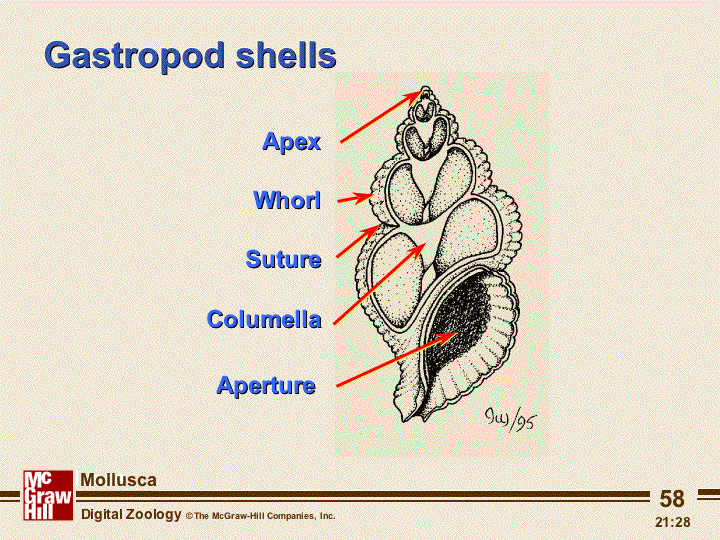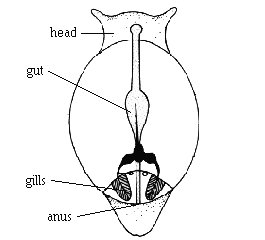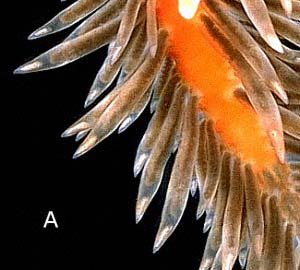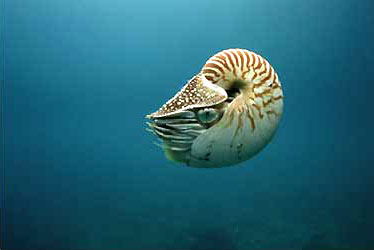
The Class Gastropoda includes the snails and slugs.
One of the most diverse clades of mollusks, with 80% of molluscan species
Univalve, conical, often coiled shells
Cephalization: head contains sense organs such as eyes and tentacles
Torsion found in some forms: during development, body rotates counter-clockwise
Torsion usually starts in the veliger or winged larvae stage.
Gastropods are by far the largest group of molluscs. Their 40,000 species comprise over 80% of living molluscs. Gastropod feeding habits are extremely varied, although most species make use of a radula in some aspect of their feeding behavior. Some graze, some browse, some feed on plankton, some are scavengers or detritivores, some are active carnivores.

Most gastropods have a single, usually spirally coiled shell into which the body can be withdrawn, but the shell is lost or reduced some important groups. Many snails have an operculum, a horny plate that seals the opening when the snail's body is drawn into the shell.
This url shows the operculum of various snails.
A few conch use their operculum defensively.

Gastropods often produce mucus that is very important to moving, especially on land.
Genetics
One of the first early mutations discovered was a maternal effect mutation that determined whether shells in the snail Limnaea coiled to the left rather than the right.

Due to orientation of cells after early divisions in embryo.
Be able to explain the following genetics.
Gastropods are characterized by "torsion," a process that results in the rotation of the visceral mass and mantle on the foot. The result is that the mantle cavity (including anus) lies in the anterior body, over the head and mouth, and the gut and nervous system are twisted. Torsion takes place during the veliger stage, usually very rapidly. During torsion, most of the body behind the head, including the mantle, mantle cavity and visceral mass are twisted counter-clockwise (when viewed from the dorsal surface as in the figure below) through 180 degrees. Veligers are at first bilaterally symmetric, but torsion destroys this pattern and results in an asymmetric adult. Some species reverse torsion ("detorsion"), but evidence of having passed through a twisted phase can be seen in the anatomy of these forms.



Common forms, such as the snails in your yard, can be hermaphrodites. Hermaphroditic forms exchange bundles of sperm to avoid self-fertilization; copulation may be complex and in some species involves an individual sending a dart into the tissues of the other.


Many marine species have veliger larvae or larvae with wings. Trochophore larvae can develop into veliger larvae.

Nudibranchs have soft bodies and most of them lack an external protective shell.
Some nudibranchs have numerous body projections (called "cerata") increasing the overall body surface and enhancing breathing. Some species extract nematocysts from the coelenterates on which they feed and store them in the special sacs at the tips of their ceratas called cnidosacs.

The lion maned nudibranch have has a large expandable oral hood which is fringed with sensory tentacles.
These nudibranchs are on the following list of deadly slugs and snails http://www.bogleech.com/bio-gastropoda.html
Other nudibranchs produce toxins that appear to discourage predators. http://www.seaslugforum.net/factsheet.cfm?base=aposemat
The nudibranchs are a groups of snails that have undergone detorsion. http://www.seaslugforum.net/find/detort
Class Cephalopoda
(octopuses and squids)
Univalve conical shell
• Exclusively marine
• Predatory (possible planktonivores in ammonoids)
• Most sophisticated brains among invertebrates
• Camerate (chambered) shell: may be coiled or straight
• Beak
The Cephalopoda is an ancient and very successful group of the Mollusca. Cephalopods have been among the dominant large predators in the ocean at various times in geological history. Two groups of cephalopods exist today: The Nautiloidea with a few species of the pearly nautilus, and the Coleoidea, containing the squids, cuttlefishes, octopods and vampire squids, which is represented by about 700 species. Cephalopods are the most active of the molluscs and some squids rival fishes in their swimming speed. Although there are relatively few species of living cephalopods, they occupy a great variety of habitats in all of the world's oceans. Individual species are often very abundant and provide major targets for marine fisheries.
Cephalopods first appeared about 500 million years ago in the Upper Cambrian Period.
Cephalopods have been among the dominant large predators in the ocean at various times in geological history. Two groups of cephalopods exist today: The Nautiloidea with a few species of the pearly nautilus, and the Coleoidea, containing the squids, cuttlefishes, octopods and vampire squids, which is represented by about 700 species. When cephalopods first evolved, the primary feature that separated them from other molluscs was a shell with buoyancy chambers. This allowed cephalopods to invade the pelagic realm where predators and competitors were few.


The major change from the basic molluscan plan exhibited by the cephalopods is the alteration of much of the original foot into a series of large prehensile TENTACLES or arms at the anterior end which now surround the head. The mantle surrounds the visceral sac and possesses strong muscles required for contraction of the cavity and respiration. An opening in the mantle cavity serves as an inhalant aperture, whereas the funnel serves as the exhalent aperture. Water is taken into the mantle (body) cavity for respiration, through the opening between the mantle and head. Contraction of mantle muscles expels the water from the mantle cavity through the funnel (a small ventral tube,sometimes called a siphon) for propulsion and elimination of waste products, in addition to completion of the respiratory cycle.

All cephalopods have one pair of unciliated ctenidia within the mantle cavity, with the exception of Nautilus, which has two pairs of ctenidia. The movement of water over the ctenidia is controlled by muscular contractions of the funnel or mantle wall. An external shell is possessed only by the Nautiloidea. Ocotopoids lack shells altogether. A cephalopod is also characterized by a horny beak secreted by the walls of the buccal cavity, and a radula within the buccal cavity.

All cephalopods are carnivorous. The strong beak is at the entrance to the buccal cavity , on the floor of which lies the radula. There are two pairs of salivary glands , one of which may be poisonous. The digestive tract consists of three parts: esophagus , which may contain a crop; stomach , which mashes food; and caecum , where most digestion and absorption occur. The posterior portion of the caecum contains a diverticulum that serves as an ink gland, producing a suspension of melanin that can be expelled through the mantle cavity.

With the exception of Nautilus, cephalopods contain pigment-rich cells in the epidermis surrounded by cells containing contractile fibers. These cells, called chromatophores, are responsible for the ability of the cephalopods to change color and patterns accurately and rapidly in response to danger or emotion. Chromatophores may also be under hormonal control. When the contractile fibers are stimulated, they contract and expose a larger amount of color.
http://www.youtube.com/watch?v=vIwjKcrxOOE&feature=related



Locomotion in cephalopods is accomplished mainly by jet propulsion. To close its mantle completely, a squid fits two cartilaginous ridges on the mantle wall into two cartilaginous grooves on the opposite funnel wall; contraction of circular muscles around the mantle cavity then forces water out the funnel. The funnel can be aimed, allowing the animal to change its direction. Locomotion in other cephalopods can be accomplished by other means. Octopoids can use their arms to "walk."

Cephalopods are gonochoric. A female typically possesses a single oviduct. A male produces spermatophores that it transfers to the female's genital pore by means of a specialized arm or tentacle. In some species, the specialized arm tip may be pinched off and left in the female's mantle cavity: this is known as the hectocotylus arm. Mating in some cephalopods includes courtship rituals that may consist of color changes, body movements, or combinations of both
http://www.youtube.com/watch?v=02zvS_QdJhw
Cephalopods exhibit spiral cleavage, but they have no larval stage: their development is direct. Octopods typically tend their eggs until hatching.
Cephalopods possess well-developed nervous systems and complex sensory organs. The ganglia are large and close to each other, forming a large brain. Certain upper lobes within the brain serve as controls for memory and learning. Cephalopods also possess ganglia elsewhere within the mantle cavity linked to the brain by giant axons that are involved with muscular contraction. The eyes in Nautilus are primitive, but in other cephalopods are highly developed and resemble vertebrate eyes with a cornea, lens, retina, and iris. These eyes are capable of forming images and distinguishing colors.

It is believed that cephalopods evolved from an ancient group of gastropods.
http://www.thecephalopodpage.org/smarts.php